Key Takeaways: Agile vs Traditional Projects
- Traditional project management methods are ideal for large projects and teams that need structure. Agile methods are for teams needing to pivot and quickly respond to change.
- Agile methods favor frequent face-to-face meetings, whereas traditional methods rely on documents and less frequent meetings.
- Both methods have similarities (meeting deadlines, producing quality deliverables, risk management and budgeting).
There is no one-size-fits-all approach to project management. Every project is unique and requires different methods to get the work done. The two mainstream methods for project managers to choose from are traditional and Agile, but how do you choose between them? Our comprehensive traditional vs Agile project management guide will help you see the light.
Below, we’ll cover the pros and cons of traditional and Agile methodologies, what you can expect when using them and how each working style is structured. We’ll even suggest the best project management software to help you along the way. By the end of this guide, you’ll know which method is right for you and your team.
What Is Traditional & Agile Project Management?
Before we get into the differences between traditional project management and Agile project management methodologies, we will take a quick look at both ways of working.
What is Traditional Project Management?
Traditional project management (Waterfall) is a linear working approach with well-defined stages and requirements. The method generally relies on Gantt charts and contains multiple phases (setting requirements and document procurement, planning, development, testing and deployment). Each phase must be completed before the project can progress.
The traditional project management methodology is not flexible. Due to its structured nature, projects following this method cannot deviate much from their initial project scopes. This is good and bad. The good thing is that the chances of scope creep are lower. The bad news is that should problems arise, there’s little room for project managers to react to them.
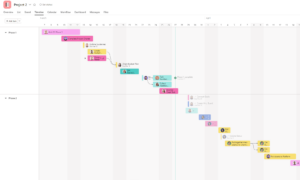
to work, that looks like a waterfall flowing down a Gantt chart.
The Waterfall methodology is championed by the Project Management Body of Knowledge, which is a set of guidelines laid out by the Project Management Institute. The methodology is ideal for large teams working on large-scale projects with detailed plans that have unchangeable deliverables.
You can learn more about courses from the Project Management Institute in our roundup of the best project management certifications. Overall, the Waterfall method is easy for a team to follow and offers a relatively straightforward approach to project management.
What Is Agile Project Management?
Agile project management is the complete opposite of traditional methods and favors flexibility and adaptability. Agile methods are iterative and eschew rigid documents, guidelines and timelines in favor of flexible timelines and open communication. The continuous feedback loop helps solve problems during every iteration of the project deliverable.
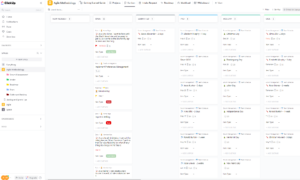
With Agile project methodologies being so fluid, they’re better suited to small- to medium-sized teams and projects (simple and complex projects). Agile methods such as Scrum, which utilize scrum masters to lead teams through a project, are often associated with software development groups. However, Agile methods are versatile and can be used by project managers across many industries.
Traditional vs Agile Project Management: Key Differences
There are many differences between Waterfall’s linear approach and Agile’s iterative approach to working. The biggest differences revolve around project flexibility, collaboration and control, documentation, and organization. Below, our table will show you the key differences between the two.
| Traits | Traditional Approach | Agile Approach |
|---|---|---|
| Communication | Formal communication is made via documents | Daily face-to-face meetings are encouraged |
| Flexibility | Plans and the need for predictable outcomes make this approach rigid | Highly flexible and can adapt to changes quickly and efficiently |
| Teams | Structured teams | Cross-functional teams |
| Project timelines | Must follow a clearly defined path | Interactive and allow changes |
| Development model | Linear | Iterative |
| Stakeholder involvement | A lot at the start but very little input during the project | Considered part of the team with high involvement throughout the project |
| Change approvals & review | Must follow formal change approval guidelines under constant review | After each sprint or development cycle |
| Development structure | Life cycle | Adaptive |
| Project sizes | Suitable for large projects | Ideal for small or medium projects |
| Control & problem-solving | Project managers have all the authority | Teams work together to problem-solve and troubleshoot |
Now that we can see some of the differences between traditional and Agile ways of working, we will quickly cover a few of the key differences in more detail.
Project Timelines and Flexibility
In the Waterfall method, project scopes have no room for change. The timeline is set, and each phase must be completed. This makes following the linear project path straightforward and usually ends with on-time deliverables. However, this approach can be problematic as once you have gone down the Waterfall method’s stages, it can be hard to go back up if there’s a problem.

so be sure to amend your project scope if changes are requested.
Agile methods such as Scrum and Kanban allow teams to turn on a dime and incorporate change requests frequently. As you can imagine, this flexible approach could alter the project end date for the better or worse and could potentially cause scope creep. Still, in industries that change quickly, a flexible approach is welcomed. This is why you see many Agile software development teams.
Documentation
Pull up the Agile Manifesto, and you’ll see that the founders wanted fewer documentation requirements compared to traditional methodologies. The Agile project management approach champions working software over documentation, whereas traditional project management approaches favor having everything in writing before and during the project.
Communication, Teams and Customer Involvement
In a traditional methodology, the project manager and stakeholders work on comprehensive documentation (customer collaboration) that covers the project scope and the way the project will progress. The steps of the project, the team structure — set via RACI charts — and the lay of the land are then discussed with the team, and internal issues are dealt with as they arise.
However, once everything has been decided, communication between the project manager and stakeholders is limited to change request orders and meetings at the end of each phase that cover progress and risk assessments.

in traditional project management methodologies.
When using Agile project management methods, open communication between the project manager or Scrum master, the team and stakeholders is ever-present. In fact, stakeholders are considered part of the team, and they have an active voice throughout the project. They can voice concerns and request changes at any time, and teams can react on the fly.
Agile methods generally use cross-functional teams that have the power to problem-solve and work in many roles as they work toward a common goal — delivery of each iteration on time. If you use Scrum methods, you’ll find that communications are taken to another level with daily scrum meetings and retrospective meetings at the end of each sprint.
Project and Team Size
Another difference between Agile and traditional project management methods regards project and team sizes. Agile teams tend to be much smaller than those found in traditional methods.
For example, Scrum teams ideally should contain 10 members at most. This is because Agile methods need extreme flexibility, and smaller groups can learn, adapt and course correct quicker than larger teams.
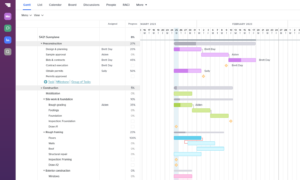
Overall, Agile project sizes are also smaller as the types of projects being worked on are prone to changes. Traditional projects that use the Waterfall method generally tend to be construction or manufacturing projects that are much larger in scope.
Similarities Between Agile & Traditional Project Management
There’s a lot of discussion about the differences between Agile and traditional project management methods. However, there are similarities, too. Ultimately, whether you want to use an Agile methodology or a traditional one, the goal is to help you plan, track, manage and create quality deliverables.
Whether you opt for a traditional or Agile project methodology, you’ll find that both incorporate time to test the deliverable. In Agile methods, testing is performed much more frequently, while a traditional approach makes the team wait until the end of a phase to test the deliverable. Still, both do support testing phases.
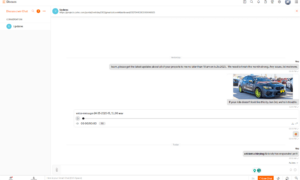
Both working styles also support budgets, risk management and reporting and need a project manager to oversee everything. In the modern world, Agile and traditional approaches are supported by project management software like those found in our roundup of the best free project management software.
Agile vs Traditional Project Management: Choosing the Correct Approach
Now that we know the key differences and similarities between Agile and traditional teams, we can take a closer look at the industries in which Agile and traditional methods are often used.
Software Development
Software development is the ideal industry for an Agile project methodology. This is because Software development teams need to be nimble and able to react quickly to stakeholder requests for new features.
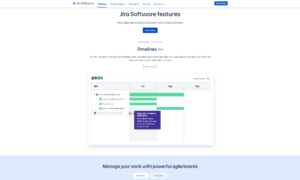
Agile methods such as Scrum and Extreme Programming are loved by software developers. More times than not, development teams will leverage kanban boards that can be found in software such as Jira (here’s our Jira review) and Wrike (here’s our Wrike review).
Construction
Construction projects are well-suited to traditional methods that include elements of Waterfall, like PRINCE2 and the Critical Path Method. These construction projects are often large, with humongous teams that feature deliverables that stay mostly the same during the project life cycle. Each part of a construction project needs to be finished in distinct stages, with reviews at the end of each.

Fortunately, almost every piece of project management software available can accommodate traditional management methods, including monday.com (here’s our monday.com review) ClickUp (check out our ClickUp Review), Zoho Projects (here’s our Zoho Projects review) and Asana (yes, we have an Asana review, too).
Digital Services
More often than not, you’ll find that firms in the digital services game follow Agile principles and methodologies. Being able to react to changing news, customer updates, new marketing trends and more requires a flexible approach, and that’s precisely what Agile methods, like Kanban, bring to the table.

Like other publications, at Cloudwards, we use the Kanban Agile project management methodology to help with our workflow.
If you’re a project manager working in a fast-paced environment who needs software to help steer teams on an ever-changing course, take a look at our roundup of the best Kanban project management apps; Trello ranks as the top Kanban tool (read our Trello review).
Manufacturing
Many manufacturing companies use traditional methods because of their structured workflows and emphasis on budgets and documenting and calculating risks (you can learn more about budgets in our article on activity-based costing). This is because manufacturing often encounters fewer changes than volatile industries like software development.
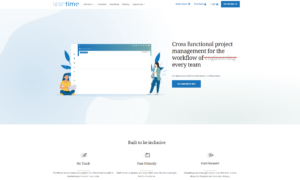
That said, many manufacturing firms are looking at hybrid methods that blend Agile and traditional methodologies. In fact, this shift to hybrid methods is the reason why software platforms like Leantime exist (check out our Leantime review).
Final Thoughts
Agile and traditional project management methodologies offer project managers the tools needed to plan, organize and track projects from start to finish. Both working styles have pros and cons and are suited to different industries and team sizes. As a project manager, you need to decide with your clients and your team which methodology is suitable for the job at hand.
We have given you the insight here to help you determine if a fast-paced, flexible approach (Agile) or a highly-structured environment (traditional) is right for your project. We hope this guide helps you weigh your options as you head into your next project.
Do you like Agile or traditional project management methodology more? Have you ever used a hybrid method? Let us know in the comments, and as always, thanks for reading.
FAQ: Agile vs Traditional Project Management
-
Traditional project management methods are highly structured, rely on extensive documentation and are best suited for large projects and teams. Agile methods are for small to medium-sized teams who value face-to-face communication, work on small to medium-sized projects and need to react to constant change.
-
Data from the Standish group will show you that Agile methods are more successful than traditional project management approaches. Still, it’s unfair to say that Agile project management is better than traditional. Both approaches have pros and cons and are suited to different industries.
-
The biggest weakness of traditional project management methods is their inability to react to change. Traditional methods are rigid, making it hard for project managers to pivot and change course should the need arise.
{“@context”:”https:\/\/schema.org”,”@type”:”FAQPage”,”mainEntity”:[{“@type”:”Question”,”name”:”What Is the Difference Between Traditional and Agile Project Management?”,”acceptedAnswer”:{“@type”:”Answer”,”text”:”
Traditional project management methods are highly structured, rely on extensive documentation and are best suited for large projects and teams. Agile methods are for small to medium-sized teams who value face-to-face communication, work on small to medium-sized projects and need to react to constant change.\n”}},{“@type”:”Question”,”name”:”Which Method Is More Successful: Agile or Traditional?”,”acceptedAnswer”:{“@type”:”Answer”,”text”:”
Data from the Standish group will show you that Agile methods are more successful than traditional project management approaches. Still, it\u2019s unfair to say that Agile project management is better than traditional. Both approaches have pros and cons and are suited to different industries.\n”}},{“@type”:”Question”,”name”:”What Are the Weaknesses of Traditional Project Management?”,”acceptedAnswer”:{“@type”:”Answer”,”text”:”
The biggest weakness of traditional project management methods is their inability to react to change. Traditional methods are rigid, making it hard for project managers to pivot and change course should the need arise.\n”}}]}
The post Traditional vs Agile Project Management in 2023: Which Is Better For Your Team? appeared first on Cloudwards.

